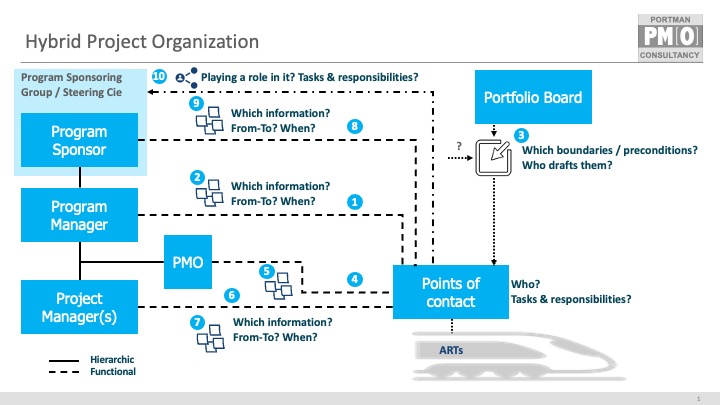The latest PMI Pulse of the Profession 2024 Report shows that hybrid gains ground as the fit-for-purpose approach, reflecting comparative data from 2022 and 2023. While the agile methodology has seen a slight decline in usage from 27% to 24.6%, and Waterfall has also decreased from 47% to 43.9%, the hybrid model has notably risen from 26% to 31.5%.
An increasing number of organizations are encountering challenges in their agile transformations. Despite establishing agile delivery organizations with continuous agile teams and scaling frameworks like SAFe’s agile release trains, they confront obstacles in fully integrating these changes, realizing benefits, and capturing value. One critical issue is the insufficiency of merely having permanent agile teams and structures such as agile release trains. Another problem arises when there is an absence of backlogs to incorporate their initiatives, or in other words, a lack of appropriate teams to address their issues. In such cases, organizations often revert to more conventional Project Portfolio Management (PPM) methods to find solutions.
As this hybrid approach to project management becomes increasingly mainstream, organizations are seeking guidance on integrating the two distinct models. However, the relationship between a project or program manager and a product manager isn’t hierarchically direct or functional.
To elucidate how a temporary project or program organization can effectively collaborate with a permanent agile delivery organization, I employ a specific model that illustrates the interfaces and facilitates a discussion about the flow of information.
1 Point of contact program manager in ARTs: The point of contact for a program manager (PgM) is product or solution management (PdM) depending on the topology of the delivery organization and the size of the request. The program manager needs the delivery organization to develop/change specific functions needed for the success of the program.
2 Information flows PgM: from PgM to PdM requirements, functions, dates, deadlines, changes, accelerate, slow down. From PdM to PgM realization dates, impact, risks.
3 Which boundaries / preconditions? Priorities, capacity for small changes, for portfolio initiatives (swim lanes) set by portfolio board. Given the absence of a hierarchical relationship, it’s crucial for Product Managers (PdMs) or Product Owners (POs) to recognize the priority of this initiative. This understanding is necessary to appropriately factor it into the prioritization of their backlog, ensuring that this initiative is duly considered.
4 Point of contact PMO in ARTs: The PMO is an attendee of the PO/SM Sync to collect the needed information.
5 Information flows PMO: From PO/SM Sync to PMO progress (e.g. Burn-up chart), issues, risks (e.g. risk burn down chart).
6 Point of contact project manager in ARTs: The point of contact for a project manager (PjM) is product management or Product Owner. depending on the topology of the delivery organization and the size of the request. The project manager needs the delivery organization to develop/change specific functions or stories needed for the success of the project.
7 Information flows PjM from PjM to PdM or PO requirements, functions, dates, deadlines, changes, accelerate, slow down. From PdM or PO to PgM realization dates, impact, risks.
8 Point of contact for program sponsor in ARTs: The point of contact for a program sponsor is the Business owner of the ART or solution train. The business owner must be aware of the objectives of the initiative. The business owner can bring this forward during the next PI event. Ideally the business owner and the program sponsor are the same person.
9 Information flows Program Sponsor. From Program sponsor to Business Owner objectives/goals of the initiative.
10 Representative of ARTs in program steering committee. To aid in decision-making during steering committee meetings, it’s essential for the business owner of the Agile Release Trains (ARTs) to attend the program steering committee meetings. As mentioned, it would be advantageous if the program sponsor and the business owner were the same individual.
Next steps
This model is a starting point, it is absolutely not perfect. I’m seeking input to refine and enhance this model. What contact points do you see? Which information flows are important to make it work. Can the model be simplified?
















